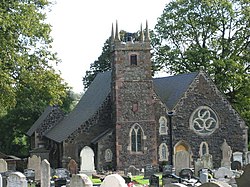Lambeg: Difference between revisions
No edit summary |
No edit summary |
||
| (One intermediate revision by the same user not shown) | |||
| Line 3: | Line 3: | ||
|county 1=Antrim | |county 1=Antrim | ||
|county 2=Down | |county 2=Down | ||
|picture=Lambeg Parish Church (C of I) - geograph.org.uk - 59095.jpg | |||
|picture caption=Lambeg Parish Church | |||
|latitude=54.5 | |latitude=54.5 | ||
|longitude=-6.033 | |longitude=-6.033 | ||
|os grid ref=J2766 | |os grid ref=J2766 | ||
|LG district=Lisburn | |LG district=Lisburn | ||
}} | }} | ||
'''Lambeg''' is a small village and parish in [[County Antrim]]. Located between [[Belfast]] and [[Lisburn]], it was once a small rural village, but is now within the Greater Belfast conurbation. The name, historically spelled ''Lanbeg'', is from the Irish ''Lann Bheag'' meaning "little church".<ref>[http://www.placenamesni.org/resultsdetail.phtml?entry=10765 Placenames NI]</ref> The parish | '''Lambeg''' is a small village and parish in [[County Antrim]]. Located between [[Belfast]] and [[Lisburn]], it was once a small rural village, but is now within the Greater Belfast conurbation. The name, historically spelled ''Lanbeg'', is from the Irish ''Lann Bheag'' meaning "little church".<ref>[http://www.placenamesni.org/resultsdetail.phtml?entry=10765 Placenames NI]</ref> The parish additionally extends into [[County Down]].<ref>{{cite web | title=Parishes of Northern Ireland| work=Public Record Office of NI| url=http://applications.proni.gov.uk/geogindx/ | accessdate=1 January 2013}}</ref> | ||
==History== | ==History== | ||
| Line 36: | Line 36: | ||
===Townlands=== | ===Townlands=== | ||
{{ | {{townlandliststart}} | ||
*[[Ballyskeagh]] | *[[Ballyskeagh]] | ||
*[[Lambeg North]] | *[[Lambeg North]] | ||
| Line 44: | Line 44: | ||
{{townlandlistend}} | {{townlandlistend}} | ||
{{commons category}} | {{commons category|Lambeg, County Antrim}} | ||
== References == | == References == | ||
{{reflist}} | {{reflist}} | ||
Latest revision as of 15:54, 8 November 2015
| Lambeg | |
| County Antrim, County Down | |
|---|---|
 Lambeg Parish Church | |
| Location | |
| Grid reference: | J2766 |
| Location: | 54°30’0"N, 6°1’59"W |
| Data | |
| Local Government | |
| Council: | Lisburn and Castlereagh |
Lambeg is a small village and parish in County Antrim. Located between Belfast and Lisburn, it was once a small rural village, but is now within the Greater Belfast conurbation. The name, historically spelled Lanbeg, is from the Irish Lann Bheag meaning "little church".[1] The parish additionally extends into County Down.[2]
History
Lambeg was originally one townland, but was split into Lambeg North (188 acres, in the barony of Belfast Upper) and Lambeg South (187 acres, in the barony of Massereene Upper)[3] with the old village of Lambeg lying in the northern half.[4]
The River Lagan flows alongside the village and it was because of the river and the damp climate of the Lagan Valley, that flax was first grown there. This resulted in Lambeg becoming a centre for the Linen industry in the area. The fertile land of the Lagan Valley was part of the manor granted in 1611 to Sir Fulke Conway. English tenants, mainly from the north of England according to Rankin, were brought over by Conway to settle on his estate. It is suggested that they also brought experience of textile making with them. The earliest documentary evidence of the textile industry in Lambeg records the setting up of a bleach green in 1626.
By 1760, Mr John Williamson owned most of the village and played a prominent role in the development of the linen trade, through ownership of the Lambeg bleach green.
The Wolfendens were another foreign family who went into exile in Lambeg and assisted in the establishing of the manufacture of linen cloth in the village. They are buried in Lambeg graveyard. The bridge over the River Lagan is still referred to as Wolfenden's Bridge.
Aberdelghy was a mid-19th century house in Lambeg. It was the seat of Alexander Airth Richardson, the son of Jonathan Richardson MP, of Lambeg, and his wife, Margaret Airth.[5]
In 1921 the Government of Northern Ireland set up a "Linen Industry Research Association" (LIRA). This was situated in Lambeg, for the scientific and technical research of textiles, especially linen. Due to the decline of the industry the centre closed in 1993, although its library of books and journals are now housed in the Lisburn Museum.
Locally significant buildings include Lambeg Old National School (1849), which is now converted to a dwelling and is a listed building.
The Lambeg drum is named after Lambeg.
Transport
- Lambeg railway station opened on 1 September 1877.[6]
Civil parish of Lambeg
The civil parish covers areas of both County Down and County Antrim. It lies in the baronies of Castlereagh Upper (3 townlands) in County Down and Belfast Upper (1 townland) and Massereene Upper (1 townland) in County Antrim. It contains the villages of Lambeg and Tullynacross.[3]
Townlands
| ("Wikimedia Commons" has material about County Antrim Lambeg) |
References
- ↑ Placenames NI
- ↑ "Parishes of Northern Ireland". Public Record Office of NI. http://applications.proni.gov.uk/geogindx/. Retrieved 1 January 2013.
- ↑ 3.0 3.1 "Lambeg". http://www.thecore.com/seanruad/. Retrieved 17 May 2015.
- ↑ Ordnance Survey Ireland: Online map viewer
- ↑ Bence-Jones, Mark (1988). A Guide to Irish Country Houses. London: Constable. p. 1. ISBN 0 09 469990 9.
- ↑ "Lambeg station" (PDF). Railscot - Irish Railways. http://www.railscot.co.uk/Ireland/Irish_railways.pdf. Retrieved 2007-08-28.

This County Antrim article is a stub: help to improve Wikishire by building it up.
